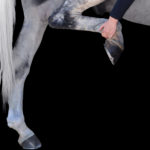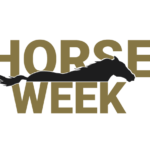He is an icon’s icon.

Bill Steinkraus, America’s first Olympic equestrian individual gold medalist; captain of the U.S. Equestrian Team and then its chairman, has earned reverential respect for his contributions to show jumping and equestrian sport in general.
He will be honored at this week’s Washington International Horse Show in conjunction with the Show Jumping Hall of Fame, which included him in its first group of inductees 24 years ago.
This is part of a new program being initiated for shows hosting classes in the Hall of Fame Jumper Classic series. The hope is to educate the next generation in the show jumping sport about legends, such as William Steinkraus, who have helped make it what it is today.
A much-admired stylist on horseback, his athletic ability was aided by a unique intellectual perspective. It is detailed in his best-known book, “Riding and Jumping,” which has become a classic, as well as in the sequel, “Reflections on Riding and Jumping.” The multi-talented rider is a violinist who also has served as an expert television commentator for the Olympics and other important competitions.
“Billy is one of the most brilliant people I’ve ever known,” said Frank Chapot, who succeeded him as team captain. “He was a great leader; very polite and very genuine.”
Bill left Yale University to serve in World War II, but as the Army became mechanized, he found himself in Burma with the last active cavalry unit, involved with a contingent of pack mules. After the 1948 Olympic Games, the Army stopped fielding equestrian teams and in 1950, the U.S. Equestrian Team was created to fill the void. Bill, who had gone back to Yale and graduated, joined the fledgling organization in its second year. By 1952, he was riding in the first of the five Olympic Games in which he would participate.
His contributions to the team were legion, both in and out of the saddle.
“As a rider and a strategist, nobody was better. He could ride with the best,” recalled Frank, who first went to Europe with Bill and the team in 1956.
“Billy could hang in there with the D’Inzeos and Hans Gunter Winkler and we didn’t have good horses then,” recalled Frank, referring to the top Italian and German riders of the day.
At that time, the principals of the USET and American Horse Shows Association included Whitney Stone, William Joshua Barney and Walter Devereaux, men who wanted to insure that the country excelled on the world equestrian stage.

“Billy had great influence on those people and they had great respect for him, and rightly so,” said Frank.
“He was the only American who had the prestige and the knowledge to further our status in international competition.”
Although another legend and Hall of Fame member, Hungarian immigrant Bertalan de Nemethy, coached the jumping team, “Billy would say who was going to ride first and who was going to ride last in the Nations’ Cup. He knew what horses to use in what classes and what horses not to use,” explained Frank.
George Morris, who also was once Bill’s teammate and now serves as the U.S. show jumping coach, remembered that the captain of the squad “was the riding example and the mentor.
“Billy’s a renaissance man,” said George. “He’s a gentleman of the highest class and very well-schooled, very intelligent and a nice person. This carried over into the horse business. He was a horseman of the first class. He was meticulous, he was scrupulously clean; his horses were the same.”
The dapper Hungarian coach and the conscientious team captain were a good combination.
“Billy brought to Bert the American connection,” explained George.
“He was the interpreter for Bert, the liaison with the American professional horsemen, and indoctrinated him into the American way of working with people and horses.”
Discussing the dynamics of the relationship, George observed, “Billy was just peaking, in a sense, when Bert came in the picture.”
The timing turned out to be propitious, because as George pointed out, “It would have been more difficult to do what he did without Billy and more difficult for Billy to do what he did without Bert.”
The relationship helped foster success.
George, Bill and Frank went to Rome in 1960 for the Olympics, where the team, which also included Hugh Wiley, earned a landmark silver medal — the best finish ever to that point for the U.S. at the world’s most important equestrian competition.

Eight years later, Bill would reach the height of his career and bring more honor to the country by winning the gold medal in Mexico City aboard Snowbound.
He became a part of history at that moment, a pioneer in an achievement that would not be replicated by an American show jumper for another 16 years.
With typical grace and modesty, Bill stated more than two decades later, “I can remember reflecting on how long the United States had been chasing that elusive individual Olymmpic gold medal, and what a tremendous amount of effort, sacrifice, generosity and support from such a huge number of people had been involved. The realization makes you feel somewhat more like an instrument of destiny than any great world-beater yourself.”
Asked to reminisce about his days competing at the Washington International, Bill said, “It had a lovely character all its own. Washington has a character all its own as the capital city, and the international flavor was even stronger, I would say, at the Washington International than at some of the other fall circuit shows.”
Washington (www.wihs.org), which runs Oct.25-30 at the Verizon Center, had been an integral part of the U.S. Equestrian Team’s show circuit every fall at the old D.C. National Guard Armory, in the days when Nations’ Cups were contested there.
“It was a wonderful experience for me, I really enjoyed it,” said Bill, who recalled Jacqueline Kennedy was on hand at the show “a time or two.”
The grand prix, always the show’s finale, had great significance for him.
“The President’s Cup was certainly a special competition. I tried very hard to win it, but I never won it,” Bill chuckled.
Being honored at Washington is happy news for Bill.
“It means a lot to me because the show has a special place in my heart and I think a special place in the awareness of the fall circuit and the minds of horse lovers,” he said.






